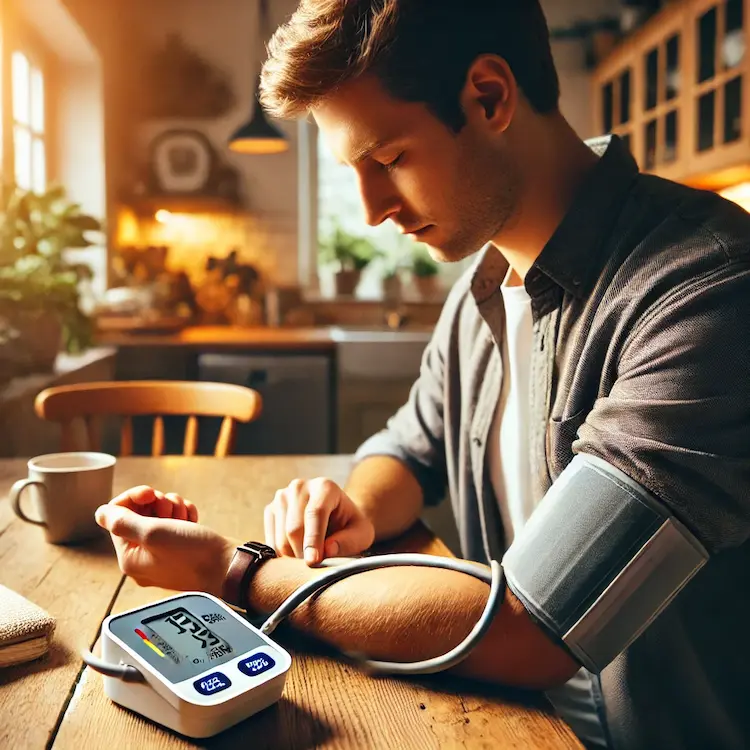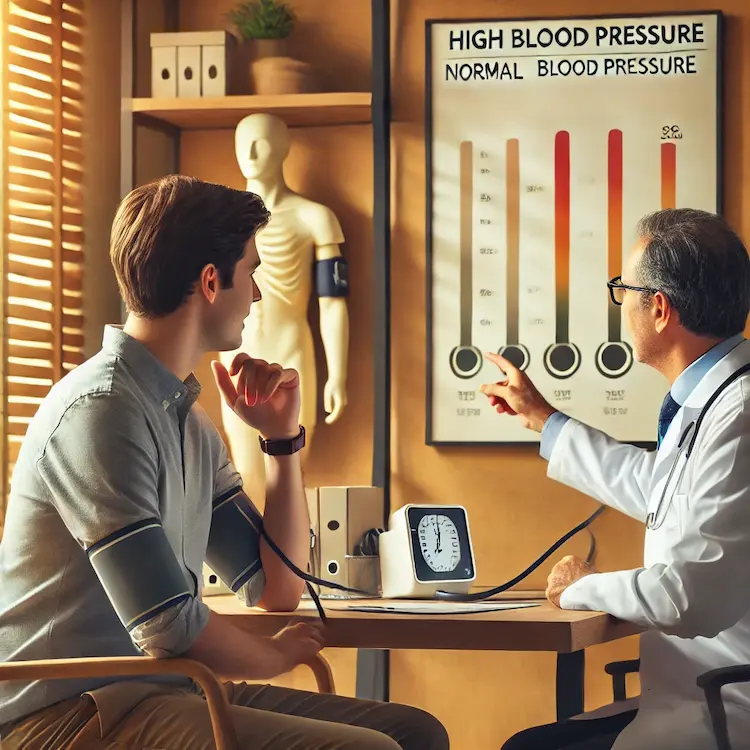Blood pressure is a vital sign that reflects the force of blood against the walls of your arteries as your heart pumps. It is measured using two numbers: systolic (the pressure when your heart beats) and diastolic (the pressure when your heart rests between beats). Monitoring blood pressure is an essential part of health management because consistently high or low readings can indicate underlying health issues. In this article, we’ll break down the importance of blood pressure readings, when you should consult your doctor, and how to manage and monitor your health effectively.
Understanding Blood Pressure Readings
Blood pressure is typically written as two numbers, like “120/80 mmHg.” The top number (systolic) represents the pressure in your arteries when your heart beats, while the bottom number (diastolic) measures the pressure when your heart rests. Here’s what the different ranges mean:
- Normal: Below 120/80 mmHg
- Elevated: Systolic between 120-129 and diastolic below 80 mmHg
- Hypertension Stage 1: Systolic between 130-139 or diastolic between 80-89 mmHg
- Hypertension Stage 2: Systolic at least 140 or diastolic at least 90 mmHg
- Hypertensive Crisis: Systolic above 180 and/or diastolic above 120 mmHg
Regular monitoring helps track fluctuations and catch any signs of abnormal blood pressure early. If your blood pressure readings are consistently out of the normal range, it’s crucial to consult a healthcare professional.

When to Consult Your Doctor: Key Indicators
While it’s essential to check your blood pressure regularly, knowing when to seek medical advice is equally important. Below are specific circumstances when you should consult your doctor:
If Your Blood Pressure Is Persistently High
- Elevated or Hypertension Stage 1: If your readings are consistently elevated or fall into Stage 1 hypertension, your doctor may recommend lifestyle changes or medication to manage your blood pressure.
- Stage 2 Hypertension: At this stage, intervention is typically necessary to prevent complications like heart disease, stroke, or kidney damage.
- Hypertensive Crisis: If your systolic pressure exceeds 180 or diastolic exceeds 120, immediate medical attention is required to prevent life-threatening conditions like organ damage or stroke.
If You Experience Symptoms of Hypertension
Hypertension is often called the “silent killer” because it may not show symptoms until it reaches a dangerous level. However, some people with high blood pressure may experience symptoms such as:
- Severe headaches
- Shortness of breath
- Chest pain
- Dizziness or lightheadedness
- Blurry vision
If you experience any of these symptoms, seek medical attention right away, especially if your blood pressure readings indicate Stage 2 hypertension or hypertensive crisis.
If You Have Existing Heart Disease or Risk Factors
People with a history of heart disease, diabetes, kidney disease, or a family history of hypertension are at higher risk of developing high blood pressure. Even if your blood pressure readings fall within the normal range, it’s important to monitor it closely. Your doctor will guide you on the best preventive measures based on your overall health status.
If You Are Pregnant or Have Pre-eclampsia
High blood pressure during pregnancy, also known as gestational hypertension, or pre-eclampsia (a condition involving high blood pressure and signs of damage to other organs), can be harmful to both the mother and the baby. Regular monitoring during pregnancy is crucial. If your readings are elevated, your healthcare provider may recommend additional tests or treatments to ensure both you and your baby stay healthy.
Methods for Monitoring Blood Pressure
There are several ways to monitor blood pressure, ranging from in-office visits to home monitoring. Understanding the differences between these methods can help you determine the best approach for your health management.
Office Visits
- Pros: Accurate and reliable measurements performed by trained healthcare professionals.
- Cons: May not reflect daily fluctuations; limited to visits every few weeks or months.
- Recommended for: Initial diagnosis, regular check-ups, or patients with complex health conditions.
At-Home Monitoring
- Pros: Convenient, allows for daily tracking, and helps detect fluctuations not captured during doctor visits.
- Cons: May result in inaccuracies if the equipment is improperly used.
- Recommended for: People with hypertension, those at risk of hypertension, or anyone advised to track their blood pressure regularly.
Ambulatory Blood Pressure Monitoring (ABPM)
- Pros: Provides a 24-hour reading, capturing variations in blood pressure throughout the day and night.
- Cons: More expensive and less accessible.
- Recommended for: Diagnosis of white coat hypertension (elevated readings in a clinical setting) or masked hypertension (normal readings at the doctor’s office but elevated at home).
Smart Wearables
- Pros: Easy to use, tracks continuously, and some devices integrate with smartphones for data analysis.
- Cons: May lack accuracy and is not a substitute for clinical measurement.
- Recommended for: Individuals who want to monitor trends over time or manage mild hypertension.
Health Implications of High Blood Pressure
High blood pressure can lead to a range of health complications. If left untreated, it can cause:
- Heart Disease: Increased pressure damages blood vessels, raising the risk of coronary artery disease, heart attack, and heart failure.
- Stroke: High blood pressure weakens and narrows blood vessels in the brain, increasing the risk of a stroke.
- Kidney Disease: Elevated pressure can damage the kidneys, leading to chronic kidney disease or failure.
- Vision Loss: Hypertension can damage the blood vessels in the eyes, leading to vision impairment or blindness.
- Dementia: Over time, high blood pressure can contribute to cognitive decline and increase the risk of dementia.

Preventive Measures and Management
If your blood pressure readings are on the higher end of the spectrum, there are several strategies you can use to reduce your risk:
Lifestyle Changes
- Diet: A balanced diet, low in sodium and rich in fruits, vegetables, and whole grains, can significantly reduce blood pressure.
- Exercise: Regular physical activity helps maintain a healthy weight and improves heart health.
- Weight Management: Maintaining a healthy weight can reduce the strain on your heart and lower your blood pressure.
- Stress Management: Practice relaxation techniques such as meditation, deep breathing, or yoga to reduce stress levels.
- Limiting Alcohol and Tobacco Use: Both alcohol and smoking can raise blood pressure. Moderating or avoiding these habits can improve your readings.
Medications
If lifestyle changes are insufficient, medications like diuretics, ACE inhibitors, beta-blockers, or calcium channel blockers may be prescribed to help manage high blood pressure.
Conclusion and Key Takeaways
Understanding when to consult your doctor about your blood pressure readings is crucial for preventing severe health complications. Regular monitoring, early detection, and lifestyle changes can significantly reduce the risk of heart disease, stroke, and other related health issues. If you notice unusual symptoms or experience consistently high readings, seek medical advice promptly.
Key Recommendations
- Monitor your blood pressure regularly, especially if you have risk factors like heart disease, diabetes, or a family history of hypertension.
- Consult your doctor if your readings are consistently elevated or if you experience symptoms like chest pain, dizziness, or shortness of breath.
- Consider home monitoring or ambulatory blood pressure monitoring for a more accurate understanding of your blood pressure patterns.

